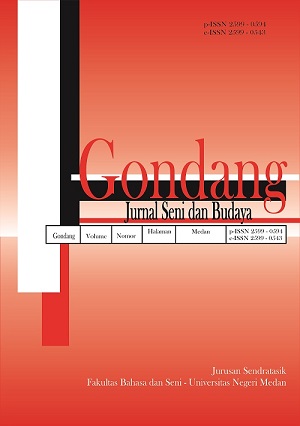Musical Ability and Interpersonal Intelligence in The Late Childhood Period
DOI:
https://doi.org/10.24114/gondang.v4i2.18867Keywords:
musical ability, interpersonal intelligence, late childhood.Abstract
Learning to adjust to peers and develop attitudes towards social groups and institutions is one of the developmental tasks of late childhood. Musical abilities present as innate and function since childhood.Associated with two things namely interpersonal intelligence and musical abilities, both are being developed in late childhood. This study aims to determine whether there is a relationship between musical ability and interpersonal intelligence in the late childhood period. This research uses quantitative research method with the type of correlation. The population of this research was all students in grade 1-3 of Pangen Gudang Purworejo State Elementary School with a total of 107 people. The sample in this study was taken proportionally stratified random sampling, with a sample size of 32 people. The data collection was carried out by using questionnaire and test techniques. The data analysis uses product moment correlation, with musical ability as the independent variable and interpersonal intelligence as the dependent variable. The result showed that there was a strong and significant positive relationship between musical abilities and interpersonal intelligence in children during late childhood period. This evidence was obtained by r count > r table (0.643> 0.349) at 5% significance level. This means that the higher the musical ability, the higher the interpersonal intelligence students will have.References
Altan, M. Z., Gardner, H., & Altan, M. Z. (2001). Intelligence Reframed: Multiple Intelligences for the 21st Century. TESOL Quarterly. https://doi.org/10.2307/3587873
Gardner, H., & Hatch, T. (1989). Educational Implications of the Theory of Multiple Intelligences. Educational Researcher. https://doi.org/10.3102/0013189X018008004
Gordon, E. (1967). The Musical Aptitude Profile. Music Educators Journal. https://doi.org/10.2307/3390915
Gordon, E. E. (1979). Developmental music aptitude as measured by the primary measures of music audiation. Psychology of Music. https://doi.org/10.1177/030573567971005
Hallam, S. (2010). 21st century conceptions of musical ability. Psychology of Music. https://doi.org/10.1177/0305735609351922
Hurlock, E. (2014). Perkembangan Anak Edisi Keenam Jilid I. Jakarta. In Penerbit Erlangga. https://doi.org/10.1078/0944-2006-00091
Quadratullah, M. F. (2014). ¢ Statistika Terapan. Penerbit Andi Yogyakarta.
Rumapea, M. E. M. (2019). Tantangan Pembelajaran Musik Pada Era Digital. Gondang: Jurnal Seni Dan Budaya. https://doi.org/10.24114/gondang.v3i2.13168
Santrock, J. W. (2011). Educational Psychology 5th Edition. In Educational Psychology. https://doi.org/10.1017/CBO9781107415324.004
Seashore, C. E. (2011). The psychology of musical talent. In The psychology of musical talent. https://doi.org/10.1037/13031-000
Sumaryanto, T. (2000). Oleh F. Totok Sumaryanto. Harmonia: Journal of Arts Research and Education.
Downloads
Published
How to Cite
Issue
Section
License
Copyright (c) 2020 Gondang: Jurnal Seni dan Budaya

This work is licensed under a Creative Commons Attribution 4.0 International License.

This work is licensed under a Creative Commons Attribution-NonCommercial-ShareAlike 4.0 International License.

